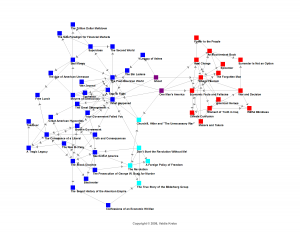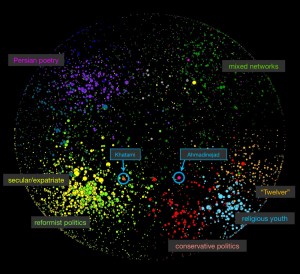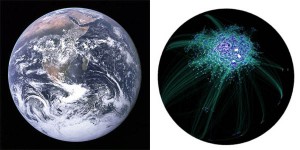If we deliver to each person only what they say they want to hear, maybe we end up with a society of narrow-minded individualists. It’s exciting to contemplate news sources that (successfully) predict the sorts of headlines that each user will want to read, but in the extreme case we are reduced to a journalism of the Daily Me: each person isolated inside their own little reflective bubble.
The good news is, specialized maps can show us what we are missing. That’s why I think they need to be standard on all information delivery systems.
For the first time in history, it is possible to map with some accuracy the information that free-range consumers choose for themselves. A famous example is the graph of political booksales produced by orgnet.com:

Here, two books are connected by a line if consumers tended to buy both. What we see is what we always suspected: a stark polarization. For the most part, each person reads either liberal or conservative books. Each of us lives in one information world but not the other. Despite the Enlightenment ideal of free debate, real-world data shows that we do not seek out contradictory viewpoints.
Which was fine, maybe, when the front page brought them to us. When information distribution was monopolized by a small number of newspapers and broadcasters, we had no choice but to be exposed to stories that we might not have picked for ourselves. Whatever charges one can press against biased editors of the past, most of them felt that they had a duty to diversity.
In the age of disaggregation, maybe the money is in giving people what they want. Unfortunately, there is a real possibility that we want is to have our existing opinions confirmed. You and I and everyone else are going to be far more likely to click through from a headline that confirms what we already believe than from one which challenges us. “I don’t need to read that,” we’ll say, “it’s clearly just biased crap.” The computers will see this, and any sort of recommendation algorithm will quickly end up as a mirror to our preconceptions.
It’s a positive feedback loop that will first split us along existing ideological cleavages, then finer and finer. In the extreme, each of us will be alone in a world that never presents information to the contrary.
We could try to design our systems to recommend a more diverse range of articles (an idea I explored previously) but the problem is, how? Any sort of agenda-setting system that relies on what our friends like will only amplify polarities, while anything based on global criteria is necessarily normative — it makes judgements on what everyone should be seeing. This gets us right back into all the classic problems of ideology and bias — how do we measure diversity of viewpoint? And even if we could agree on a definition of what a “healthy” range sources is, no one likes to be told what to read.
I think that maps are the way out. Instead of trying to decide what someone “should” see, just make clear to them what they could see.
An information consumption system — an RSS reader, online newspapers, Facebook — could include a map of the infosphere as a standard feature. There are many ways to draw such a map, but the visual metaphor is well-established: each node is an information item (an article, video, etc.) while the links between items indicate their “similarity” in terms of worldview.

This is less abstract than it seems, and with good visual design these sorts of pictures can be immediately obvious. Popular nodes could be drawn larger; closely related nodes could be clustered. The links themselves could be generated from co-consumption data: when one user views two different items, the link between those items gets slightly stronger. There are other ways of classifying items as related — as belonging to similar worldviews — but co-consumption is probably as good a metric as any, and in fact co-purchasing data is at the core of Amazon’s successful recommendation system.
The concepts involved are hardly new, and many maps have been made at the site level where each node is an entire blog, such as the map of the Iranian blogosphere above. However, we have never had a map of individual news items, and never in real-time for everyone to see.
Each map also needs a “you are here” indicator.
This would be nothing more than some way of marking items that the user has personally viewed. Highlight them, center them on the map, and zoom in. But don’t zoom in too much. The whole purpose of the map is to show each of us how small, how narrow and unchallenging our information consumption patterns actually are. We will each discover that we live in a particular city-cluster of information sources, on a particular continent of language, ideology, or culture. A map literally lets you see this at a glance — and you can click on far-away nodes for instant travel to distant worldviews.
Giving people only what they like risks turning journalism into entertainment or narcissism. Forcing people to see things that they are not interested in is a losing strategy, and we there isn’t any obvious way to decide what we should see. Showing people a map of the broader world they live in is universally acceptable, and can only encourage curiosity.





